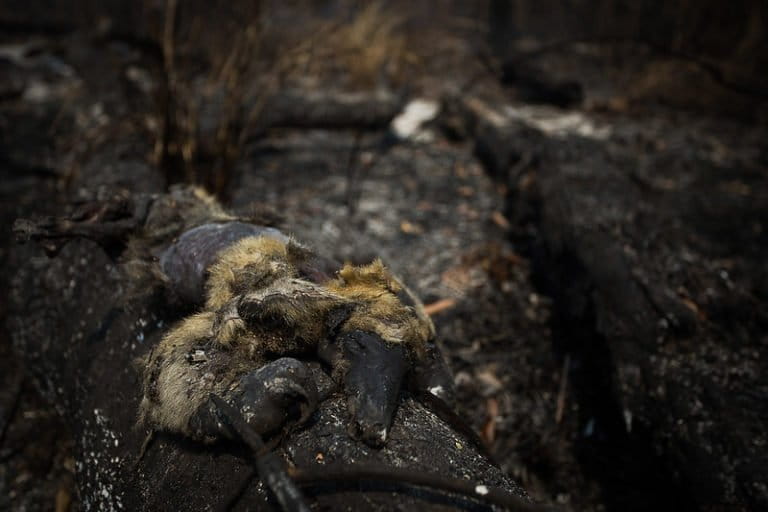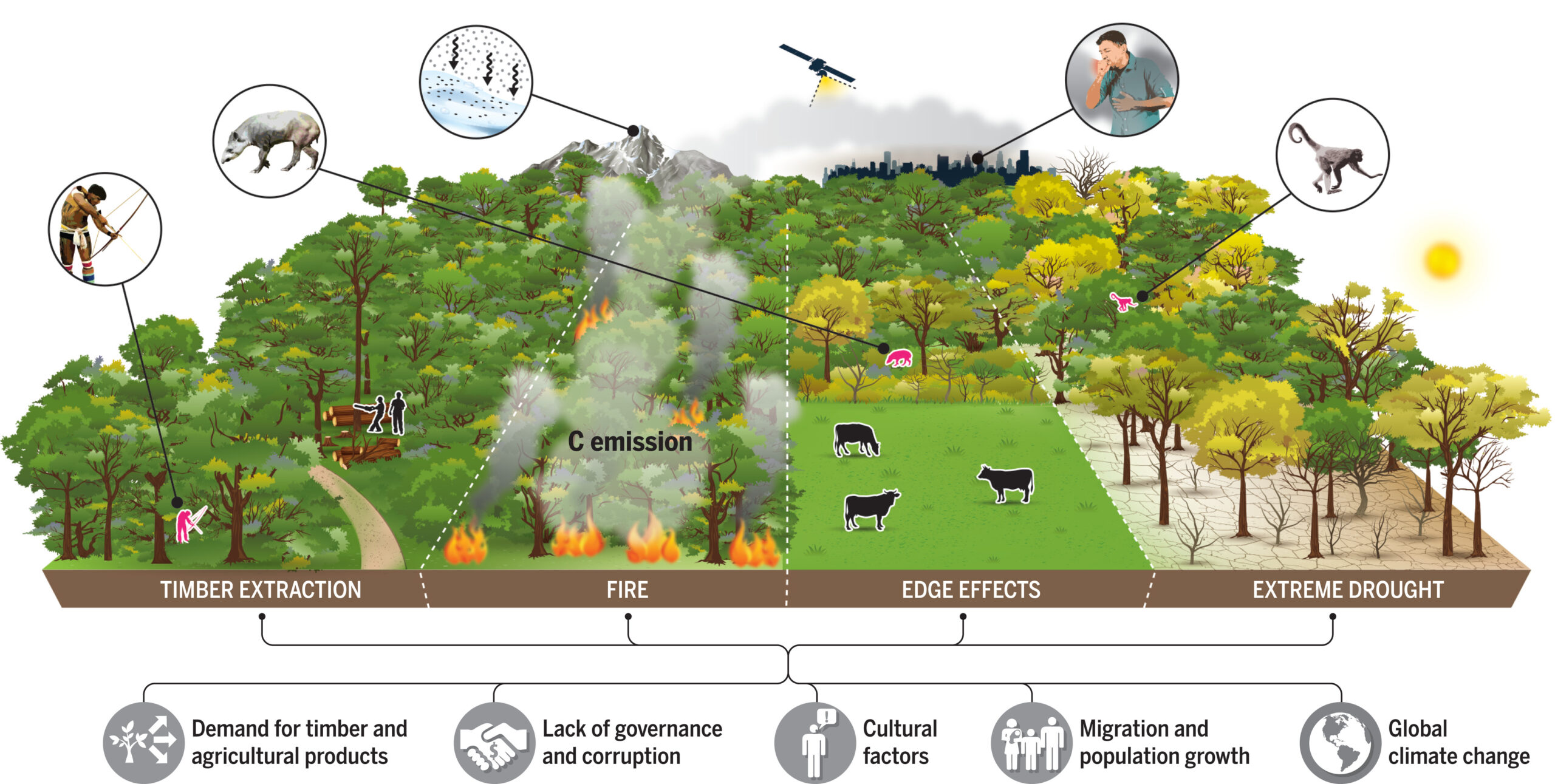- According to a new study signed by 35 scientists from all over the world, more than 1 million square miles of what remains of the Amazon Forest are suffering from degradation; this is more than 10 times the size of the UK.
- Unlike deforestation, which can be seen by satellite, degradation is more difficult to measure, but the forests impacted can emit as much carbon as areas where trees have already been cut down.
- The authors state that degradation is being driven by four main disturbances: forest fires, timber extraction, extreme droughts — intensified by climate change — and edge effects (impact of cleared areas on adjacent forests).
When we speak about destruction of the Amazon, deforestation data are often the reference. Over the last few decades, it is the rates of clear cutting that are best documented, making headlines and guiding environmental protection strategies.
“Historically, deforestation was the main driver of land use change in the Amazon. Between 1975 and 1985, almost 115,000 square miles were deforested in the Brazilian Amazon, especially by removing forests and replacing them with pastures and livestock,” says climatologist Carlos Nobre, chair of the Brazilian Panel on Climate Change and senior researcher at the Institute for Advanced Studies of the Federal University of São Paulo.
However, over time, there has been an increase in the areas that were not completely deforested but suffered various stages of degradation.
“Deforestation is really important – but yes, if we only look at that, we ignore changes in the remaining forests that can emit as much CO2 as deforestation,” warns professor Jos Barlow from the UK’s Lancaster University, co-founder of the Sustainable Amazon Network and one of the co-authors of an article recently published in the journal Science titled “The drivers and impacts of Amazon forest degradation.”
A group of 35 scientists from various international institutions, including several Brazilian researchers, conducted a new study that not only measures the exact extent of degradation in all Amazonian countries but also assesses the intensity of that disturbance, locates the areas most affected, reveals key drivers and presents their impacts at local, regional and global levels.

To begin with, the researchers emphasize the distinction between deforestation and degradation.
“Deforestation is the removal of trees and the conversion to another land use, which is normally agriculture. Degradation occurs in the forest that is left. Severe disturbances could lead to the loss of most trees, but if the land use does not change, it is degradation and not deforestation,” Barlow explains.
According to the analysis, based on previous studies conducted between 2001 and 2018, 38% of what remains of the Amazon Forest — that is, what has not been deforested yet — suffers from some type of degradation caused by human action.
“We are talking about 1 million square miles; that’s more than 10 times the size of the UK,” Professor Barlow points out.
The authors point out that degradation is being driven by four main disturbances: forest fires, timber extraction, extreme droughts — intensified by human-induced climate change — and edge effects (impact of open areas on adjacent forests).

“It’s surprising that 38% of the forest is already undergoing this process, unfortunately,” says Patricia Pinho, deputy science director of the Amazon Environmental Research Institute and one of the co-authors of the study. “When you look at the magnitude of this, not counting the areas that have already been deforested, it really sounds like a warning sign for our forest.”
Loss of biodiversity and increase in CO2
The researchers also demonstrated an association between the vectors for degradation and the drivers of deforestation, which often “co-occur and interact,” as the article points out.
Timber extraction, for example, is driven by market demand but facilitated by corruption and weak governance (85% of logging in the Amazon is illegal). Forest fires are usually caused by agricultural practices and are often exacerbated by extreme droughts. They also become more intense in areas where there is already an edge effect.
And both deforestation and what are called “forest disturbances” mean the Amazon ceases to play its extremely important environmental role in absorbing carbon dioxide from the atmosphere — and, in a perverse change of function, becomes a source of CO2 emissions.

“We compared estimates from a range of studies, and show that deforestation and degradation emission are actually very similar. Although deforestation is obviously more severe, degradation affects a much larger area,” says Barlow.
While degraded areas emit enormous amounts of greenhouse gases, they are not included in national emissions inventories. “These are not official numbers, but there are many emissions in these areas,” Nobre points out.
In addition to contributing to increased global temperature, a forest degraded by serious disturbances such as fires has a very different structure, and this impacts the species that live in it, whether they are animals or plants. As a domino effect, after its biodiversity is affected, the communities that live around it will also begin to suffer from these ills.
“This is a very important point made by the study. We expose those who benefit from these forest degradation disturbances and those who bear the brunt of the losses,” Pinho says.
In the case of timber extraction, for example, it is the regional and global actors, including companies and industries, that pocket the highest profits, leaving local workers to deal with any conflicts and violence arising from the activity or at least with the impact of the scarcity of vegetation on the supply of water resources.

Extreme droughts have become more frequent
One of today’s main experts in mapping land cover and land use — forestry engineer Tasso Azevedo, who is the co-founder and head of the MapBiomas initiative – recognizes that clear-cutting is always easier to identify, while forest degradation is much more difficult to pinpoint.
“For example, signs of regeneration can be confused with degradation, and that makes us pay less attention,” he says. “But it also affects the forest’s functionalities. Deforested, it loses its function completely and degrades part of those functions.”
For Azevedo, among the vectors presented by the new study, climate change is certainly the most important cause for concern since it does not depend on a specific and local action; rather, it demands global reduction of greenhouse gases.

“However, this degradation caused by climate change is intensified and amplified by what is done directly in the forest. So, if there is no deforestation, the effect of climate change on it will be smaller,” he says.
One of the points raised by the researchers in the article is precisely the higher frequency of extreme droughts in the Amazon, mainly in its southern and central regions. During almost two decades covered by the study, four of these events of greater magnitude were recorded.
Increasingly frequent, long and intense, these “megadroughts” induce the expansion of fire, which spreads rapidly across the forest floor and causes the death of thousands of trees.
In order to halt this scenario of devastation, the authors of the article recommend relentless fights against deforestation and measures to contain degradation activities in the Amazon.
“Despite the results of the study, there is room for hope,” says Barlow. Curtailing further deforestation will help, as it will avoid new edge effects and reduce the expansion of ignition sources that start forest fires. But we need measures that also address the drivers of disturbances too – cracking down on illegal logging, finding ways to manage fire with fewer risks. Globally, we need action to limit climate change too, as this may be linked to extreme droughts. There are many challenges – but given the importance of the region for people and nature, failure is not an option”.
Banner image: Fire in Rondônia state, in August 2020. Photo by Bruno Kelly/Amazônia Real.
Citation:
Lapola, D. M., Pinho, P., Barlow, J., O.C. Aragão, L. E., Berenguer, E., Carmenta, R., … Walker, W. S. (2023). The drivers and impacts of Amazon forest degradation. Science. Retrieved from https://www.science.org/doi/full/10.1126/science.abp8622
This article was first published by here by our Mongabay Brasil team on Feb. 1, 2023.
